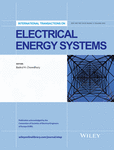Design of multi-step LC compensator for time-varying nonlinear loads based on genetic algorithm
Summary
This article presents a method to consider the probabilistic nature of load impedance and harmonic currents by designing a multi-step inductive-capacitive (LC) compensator consisting of switchable units thus assuming that a single unit is not sufficient to ensure satisfactory results. The proposed algorithm divides the time period into sub-regions according to the scheduled number of switchable units over which the multi-step LC compensator is optimized through different performance criteria; maximizing the power factor (PF), minimizing the transmission loss (TL) or minimizing the voltage total harmonic distortion (VTHD); as objective function resulting in lower variance, and hence, the more accurate expectation is obtained. Genetic algorithm (GA) is used to estimate that steps while holding the performance quantities at the corresponding desired values and constraining the compensator values which would create resonance. Also, the manufacturer's standard values for power shunt capacitors with/without equal steps are considered. GA is a search mechanism based on the principle of natural selection and population genetics. The contribution of the proposed procedure is demonstrated in examples taken from previous publications. Finally, simulated results show that the multi-step LC compensator provides a considerable improvement in the performance in case of the probabilistic condition. Copyright © 2016 John Wiley & Sons, Ltd.




